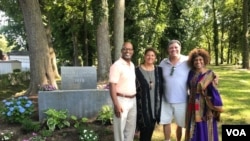The moment I entered Fort Monroe, I sensed the history of these grounds. The sprawling fort sits at the mouth of the Chesapeake Bay in Hampton, Virginia. Its high granite walls were built to keep out foreign invaders in the early 1800s, when the area was known as Port Comfort. Today, the United States is commemorating what took place on this strip of land 400 years ago.
On my tour, I came across a historical marker next to a sea wall. It told the story of the first enslaved Africans who landed at this location aboard a ship called the White Lion in August 1619. I knew little about this history but soon realized that slavery began in Virginia and, amazingly, started to unravel in this same spot.
Slavery was America's original sin and one of the darkest chapter's in the nation's history, lasting for more than two centuries. Despite the brutality of what happened centuries ago, as a TV reporter I wanted to portray the richness of U.S. history to VOA's worldwide audience. In the course of my reporting, with travels to Rhode Island and South Carolina, I learned much about the U.S. slave trade and my own African-American ancestry.
In Virginia, I met and interviewed historians who told me about two enslaved people named Antoney and Isabell, the first African family recorded in the English-speaking colony. My reporting led me to direct descendants of their son, William Tucker, the first documented African baby born and baptized in the colony.
We met at the Tucker family cemetery where marked graves date back to the 1800s. Researchers have also discovered more than 100 unmarked graves, which could date back to the 1700s. Now efforts are underway to preserve this two-acre site, where the remains of William Tucker may be located. All that is known for sure, however, is that he lived on a plantation nearby.
My drone operator and I traveled to Jamestown, Virginia, which historians believe was home to Angela, one of the first black women in the colony. We captured video from the ground and air to give viewers a feel for the landscape. Angela is the only woman listed on records, and probably came from the West African country of Angola. An archaeological dig is underway to unearth clues about her life and those of the first Africans to arrive in Virginia -- the first generation of Africans who helped create a new America.
I returned to Hampton to discover another piece of Civil War history, touring the area where thousands of runaway slaves of all ages sought sanctuary at Fort Monroe. Here, Union soldiers classified the runaways as seized "contraband of war" to justify not returning them to their white owners. During this visit, I learned that 200,000 blacks, many of them former slaves, fought and died with the Union Army.
In the Fort Monroe Museum, I noticed a picture of Union Major General Benjamin Butler, who had been determined to make sure that any slaves who reached Fort Monroe maintained their freedom. Butler's Contraband Decision changed the course of the Civil War and cracked open the door to emancipation for millions of slaves. The decision would mark the beginning of the unraveling of slavery in the United States, leading to the 13th amendment to the US Constitution, which abolished the institution in 1865. It seems fitting Fort Monroe became known as Freedom's Fortress.
Before I left, I paused under the shade of a huge old tree called the "Emancipation Oak." Under this tree, historians say, blacks secretly learned to read and write. It is also said to be the site of the first Southern reading of President Abraham Lincoln's Emancipation Proclamation, declaring all persons held as slaves shall be forever free.
Almost 150 years later in 2011, the nation's first African-American president, Barack Obama, decommissioned Fort Monroe and designated it as a national monument, ensuring its rich history will be preserved for future generations.









